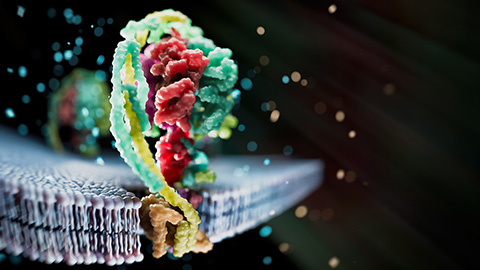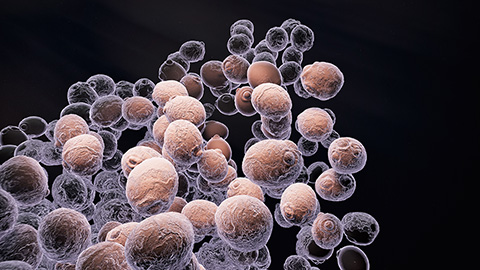Celebrating 100 years of the term ‘lipid’
Humans have recognized and used fats and oils since prehistoric times. But it was not until the 19th century that progress in chemistry and physics allowed for the discovery of biological molecules that we now understand as structurally and/or functionally related to fats, such as cholesterol, waxes and phospholipids. One hundred years ago, a French pharmacologist united all these molecules under a common name, lipides.
Gabriel Bertrand put forward the idea in his paper “Projet de reforme de la nomenclature de Chimie biologique," published by the Bulletin de la Société de Chimie Biologique. The society approved Bertrand’s suggestion,with the French spelling “lipide,” in its session on July 3, 1923.

The term lipideis derived from the Greek λίπος (fat) and ίδης (descendant of). Lipides are the progeny of λίπος just as, in the Iliad, Nestorides refers to the sons of Nestor or Telemonides to the sons or descendants of Telamon. The English-speaking world readily adopted the name lipides, in the sense defined by Bertrand, mainly in the form “lipids” (although the French spelling was kept by some authors well into the 1950s, particularly in America).
Bertrand enjoyed a long and productive scientific life. He discovered the oxidases, as well as the oligoelements, or “infiniment petits chimiques,” at the Institut Pasteur, where he worked for most of his life, even after his official retirement, until he died in 1962 at the age of 95.
On this 100th anniversary, it is perhaps pertinent to reflect on the qualities of lipids.
Definition
Among the various groups of biomolecules, lipids are unique in that they are not defined by a chemical property. Unlike in sugars (polyhydroxy aldehydes or ketones) or proteins (lineal polymers of amino acids) or nucleic acids (polymers of nucleotides), no single chemical property will fit all lipids. Instead, they are usually defined by a physical property, namely hydrophobicity.
This leads immediately to conceptual problems. For example, many membrane proteins are totally insoluble in water and soluble in chloroform–methanol mixtures, yet they are universally considered proteins, not lipids. At the opposite end of the solubility spectrum, lipids as important as the gangliosides are soluble in water and almost insoluble in organic solvents. And, in another twist, physiologically essential lipids, such as the membrane lipids, are amphipathic; that is, they contain both a hydrophobic and a hydrophilic moiety.
This complexity may explain the erroneous definitions in highly revered dictionaries and encyclopedias, or even scientific textbooks. Let me be bold enough to give, in English translation, the definition that my mentor J. M. Macarulla and I jointly proposed in our 1984 textbook “Bioquímica Humana”: “Lipids constitute a group of heterogeneous substances, sharing physical rather than chemical properties. They are sparingly or not soluble in water, and usually soluble in organic solvents” (stress not in the original text).
This somewhat fuzzy definition can be completed or clarified by a brief classification of the substances that are usually considered lipids. Two main groups must be distinguished, those of fatty acid—or fatty acid derivative—containing lipids and those broadly unrelated to fatty acids.
The first group contains the fatty acids themselves, the neutral fats or acylglycerides, the waxes, the prostanoids, the phospholipids and all the sphingolipids since sphingosine is synthesized from a fatty acid, usually palmitic.
The second group is even more heterogeneous, containing, on one side, the isoprenoids such as terpenoids, carotenoids and steroids (the latter including sterols like cholesterol, bile salts, steroid hormones, vitamin D and several plant and animal alkaloids) and, on the other, the pyrrole-related lipids such as porphyrins, heme, chlorophylls, bilifucsin and bilirubin.
Note that the latter group of lipids is usually presented in textbooks as prosthetic groups of several proteins or as degradation products, ignoring their clearly lipidic nature according to most definitions.

Landmarks
In the history of this puzzling group of biomolecules, I identify three eras, namely the unraveling of the chemical structures, the description of the metabolic pathways and the chemical–physiological correlations.
The chemical structures of most lipids had already been described by 1923, in fact, many of them were published in the 19th century. For example, Michel Eugène Chevreul isolated cholesterol in 1816, calling it cholestérine. The chemist Marcellin Berthelot discovered in 1859 the alcohol function in C3 and proposed calling it cholestérol. Aleksandr P. Borodin, a chemist and composer—known for the symphonic poem “In the Steppes of Central Asia” and the Polovtsian Dances from the opera “Prince Igor”—first isolated and described cholesterol esters in 1871. Cobalamine, or vitamin B12, resisted characterization until 1956 when Dorothy C. Hodgkin mapped its structure.
The era of the lipid metabolic pathways corresponds to the years 1942-1967. In a classical example of how the method opens the way to knowledge, the availability of carbon-14, the essential isotope for metabolite labeling, in about 1940, allowed the rapid unraveling of the main lipid pathways, completed with the biosynthesis of fatty acids, by Feodor Lynen, and of cholesterol, by Konrad Bloch, in the 1960s.
We now live in the era of the chemical-physiological correlations of lipids. Even the briefest description of the subject requires again the distinction between new techniques and new concepts.
Among the techniques that have deeply changed the fields of lipidology and lipidomics, we should mention gas-phase chromatography, thin-layer chromatography, lipoprotein electrophoresis and liquid-chromatography–mass spectrometry, which were first applied to lipids in about 1952, 1964, 1968 and 2000, respectively. It goes without saying that LC-MS has revolutionized the field of lipid analysis in physiology and pathology, at the cell, tissue and organ levels.
The novel ideas that these techniques have brought to our understanding of lipids are too important to be dealt with in a few lines. A naked enunciation of the findings should include, at the very least, phospholipids as the structural basis of membranes, in 1972; the role of diacylglycerols, in 1979, and of ceramides, in 1986, in cell signaling; adipose tissue as an endocrine tissue, in 1995; and brown fat lipids in adult-life thermogenesis, in 2009. Many other discoveries could be added to this list, but these examples are enough to illustrate the seemingly infinite capacity of lipids to dazzle us once and again.

Enjoy reading ASBMB Today?
Become a member to receive the print edition four times a year and the digital edition monthly.
Learn moreGet the latest from ASBMB Today
Enter your email address, and we’ll send you a weekly email with recent articles, interviews and more.
Latest in Science
Science highlights or most popular articles

Cholesterol as a novel biomarker for Fragile X syndrome
Researchers in Quebec identified lower levels of a brain cholesterol metabolite, 24-hydroxycholesterol, in patients with fragile X syndrome, a finding that could provide a simple blood-based biomarker for understanding and managing the condition.

How lipid metabolism shapes sperm development
Researchers at Hokkaido University identify the enzyme behind a key lipid in sperm development. The findings reveal how seminolipids shape sperm formation and may inform future diagnostics and treatments for male infertility.

Mass spec method captures proteins in native membranes
Yale scientists developed a mass spec protocol that keeps proteins in their native environment, detects intact protein complexes and tracks drug binding, offering a clearer view of membrane biology.

Laser-assisted cryoEM method preserves protein structure
University of Wisconsin–Madison researchers devised a method that prevents protein compaction during cryoEM prep, restoring natural structure for mass spec studies. The approach could expand high-resolution imaging to more complex protein systems.

Method sharpens proteome-wide view of structural changes
Researchers developed a method that improves limited proteolysis coupled with mass spectrometry, separating true changes from abundance or splicing effects.

Discoveries made possible by DNA
The discovery of DNA’s double helix revealed how genetic information is stored, copied and expressed. Revisit that breakthrough and traces how it laid the foundation for modern molecular biology, genomics and biotechnology.

